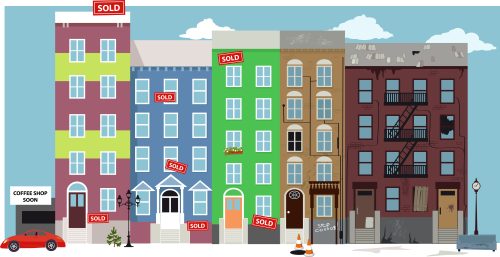The Trump tax bill contained a small provision creating many “opportunity zones” around the country, tax-preferred investment zones designed to increase private investment in low-income communities. They may initially sound like an innovative way to build up poor communities that might never be able to attract private investment, but in reality opportunity zones just offer another way for wealthy real estate investors to pay little to no taxes on large investments. With the cost of living skyrocketing and wages stagnating, Americans need affordable housing and a living wage, not another loophole for the already well off.
Let’s look at how opportunity zones actually let wealthy investors avoid paying taxes on their earnings. First of all, the Tax Cuts and Jobs Act allows investors to pay no tax on their profits from ANY past investment, as long as they invest an amount equal to those profits in an opportunity zone the same year they sell them.
So I get to avoid paying taxes on my old investments if I put those profits towards an opportunity zone. What about when I want to sell off the property in the opportunity zone I invested in? If I held the property for ten years, I would AGAIN pay no taxes on the profits from my investment, because of a single sentence in the law:
“In the case of any investment held by the taxpayer for at least 10 years and with respect to which the taxpayer makes an election under this clause, the basis of such property shall be equal to the fair market value of such investment on the date that the investment is sold or exchanged.”
This sounds complicated, but it’s actually pretty straightforward. The word “basis” is important here. When an investor calculates his or her taxable income on an investment, the income is essentially how much money you got, minus how much money you paid.
The amount of money you paid could be a little tricky, it might include commissions and other things, and it is called your “basis.” So that sentence means that in this case, after ten years, your “basis” is equal to the fair market value of your investment. If you sell the investment after ten years, the amount for which you sell the investment IS the fair market value. That means that if you sell an investment today, and reinvest in an opportunity zone, you pay zero tax on the investment you made in the past AND zero tax on the investments in the future.
So let’s say I invested $1,000 in some Apple stock when I graduated from college in 1982. That investment today would be worth about $600,000. If I sold the investment, I would have to pay a long term capital gains tax of about $86,000 (that’s not very much anyway, but that’s a different problem).
Now I could take that $600,000 and invest it in a building — say in Long Island City where Amazon was thinking of going. Let’s say that investment goes up by 2% per year for ten years (I mean 2% after all expenses, etc.) Then, I could sell the investment for $731 thousand dollars and pay ZERO taxes. Zero. Is that fair?
While the wealthy investors making money off of these opportunity zones, many of the people actually living in them are likely never going to see the economic benefits promised. Many of the designated areas within cities are urban neighborhoods of color, which already face overwhelming pressure from rising rents and gentrification. And because the loophole works best when the property is profitable, it incentivizes luxury housing and other business many of the local communities would be unlikely to afford. So rich people get tax cuts, and poor people get pushed out of their homes thanks to the very program that is supposed to help them.
Opportunity Zones are a great idea — if your goal is to ensure that rich real estate investors never need to pay any taxes at all.
